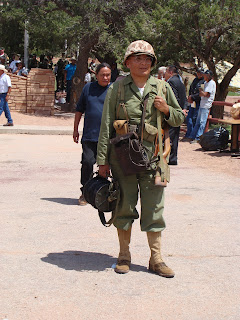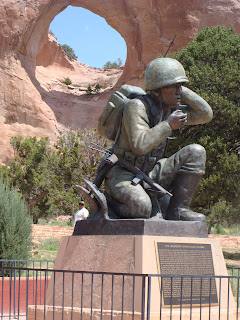NOW, THEREFORE, I, RONALD REAGAN, President of the United States of America, do hereby designate August 14, 1982, as National Navaho Code Talkers Day, a day dedicated to all members of the Navaho Nation and to all Native Americans who gave of their special talents and their lives so that others might live. I ask the American people to join me in this tribute, and I call upon Federal, State and local officials to commemorate this day with appropriate activities.
Ronald Regan 1982
Yesterday, August 14, I traveled to Window Rock Arizona to be part of an important Navajo tradition, National Navajo Code Talkers Day.
The day began with introductions and Prayer. Followed by a parade:
The parade route prepared by The Young Marines from all over the country (and I mean young, some ten or twelve years old) was lined with American flags. A roar of motor cycles at the head of the parade preceeded the Navajo Marching Band.
Then came the floats…mostly pick up trucks decorated to honor the living Navajo Codetalkers and in memory of the many who died in combat or who have passed away.
I went in part out of respect for freind Teddy Drapper Sr. who was a Code Talker and part for research…there might be a book I am working on.
 As I have been interviewing Teddy the irony is not lost. In the treaty the US government made with the Navajo in 1868, when the Navajo were allowed to return to their land after being held in Fort Sumter, the Navajo were banned from carrying weapons. In boarding school in later years Teddy and many others were punished for using the Navajo language. During WWII they were asked to pick up arms and defend the US and with the use of the Navajo lanague used in a code the Japanese could not break, they played a significant roll in the victory for allied forces.
As I have been interviewing Teddy the irony is not lost. In the treaty the US government made with the Navajo in 1868, when the Navajo were allowed to return to their land after being held in Fort Sumter, the Navajo were banned from carrying weapons. In boarding school in later years Teddy and many others were punished for using the Navajo language. During WWII they were asked to pick up arms and defend the US and with the use of the Navajo lanague used in a code the Japanese could not break, they played a significant roll in the victory for allied forces.The parade ended at the National Navajo Park. Note the window rock behind the statue of the Code Talker. The Navajo are a warrior culture and proud of their code talkers and the part they played in US history.
John Yazzie, dressed in full uniform of the Marine Communication Corps and the uniform the Codetalkers wore was a wealth of information about the radio and phones, how they worked. That roll of phone cable alone is pretty heavy.
Yes, he said that the Codetalkers were often assigned another Marine to vouch for them. In the arena of the South Pacific, the Navajo would often be mistaken for Japanese because of their Asian-like features. There was a risk they would be shot by their own troops.
The “body guard” was assigned to make sure that anyone who might question or take aim at a code talker knew that they were US Marines, not the enemy.

Code Talker GI Joe dolls? Who knew? This one actually talks. The man who showed me this doll had two he got on the internet. He was there to have all the living codetalkers sign the two boxes for his own children. His Dad had been a codetalker.
Another irony of the this whole story? I had the pleasure of meeting the Japanese photogrpaher Kenji Kawano. He has long worked with the Navajo Codtalkers and has published a book of photographs Warriors: Navajo Code Talkers. Check out his photographs: http://kenjikawano.com/bio/
Kenji said he wanted the people of the US and Japan to know the important role the codetalkers played in WWII. He will have an exhibit at the Heard Museum in Pheonix in September this year.
Finally time for the cake. When someone asked me to take a photo I could not find the cake even though I was standing in front of it. I did not recognize this codetalker radio as an edible sweet. Is it just me?
The proclomation made by Regan in 1982 also in cluded these words: From the bravery demonstrated at Valley Forge and the establishment of the U.S. Indian Scouts on August 1, 1866, to the present day, Native Americans have heeded the call to duty. Though often excluded from the annals of United States history, these people, nonetheless, have defended the only land they have ever known, asking for nothing more than opportunity in return.
The Navaho Nation, when called upon to serve the United States, contributed a precious commodity never before used in this way. In the midst of the fighting in the Pacific during World War II, a gallant group of men from the Navaho Nation utilized their language in coded form to help speed the Allied victory.
Equipped with the only foolproof, unbreakable code in the history of warfare, the code talkers confused the enemy with an earful of sounds never before heard by code experts. The dedication and unswerving devotion to duty shown by the men of the Navaho Nation in serving as radio code talkers in the Marine Corps during World War II should serve as a fine example for all Americans.
There are few Navajo Codetalkers left today as they age and pass away. But it is evident that families and friends and the proud peoples of the Navajo Nation will ensure that their legacy lives on.






